When you see El Seed’s latest sculptural work in Dubai, there is an urge to climb it. At the very least you want to touch the vibrant pink, stylised Arabic script emerging from the ground like a flame, an unfurling plant, a word breaking through the concrete.
I attempted to climb it – well, attempting to figure out how to climb it. And while I can blame my blazer for restricting my physical agency, that would be a massive lie.
You’re probably thinking, why am I trying to climb this beautiful sculpture in the first place?
Well as El Seed sees it, sometimes, that’s the point of public installations – to touch, interact with, to climb works of art that sit in the public sphere. This is his hope for the site specific piece he unveiled last week in collaboration with Tashkeel, the visual art and design studio incubator in the UAE.
It’s a colossal and stunning installation that sits right in front of the Tashkeel building, which is currently under renovations.
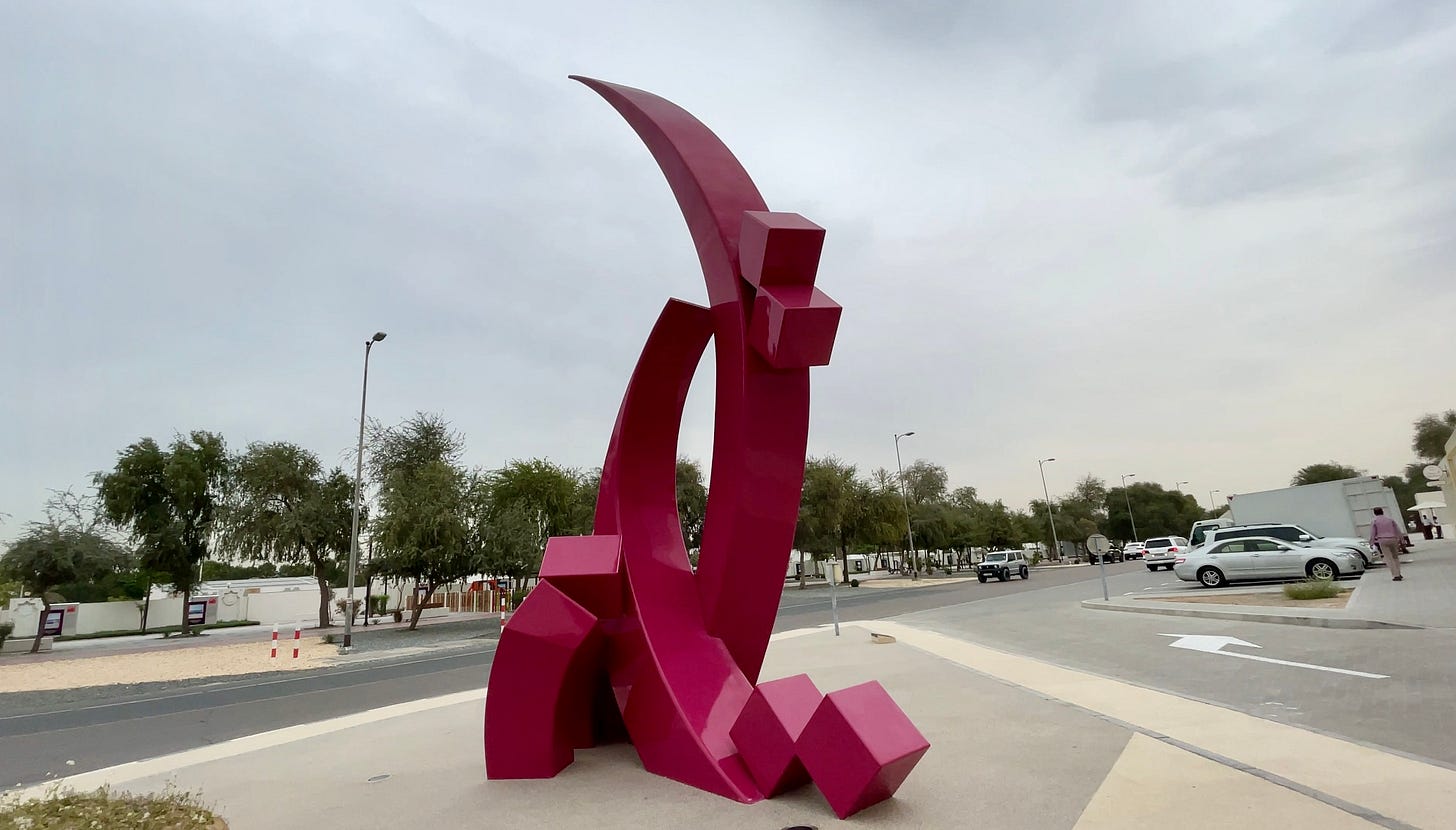
This commission and collaboration is part of the Dubai Public Art initiative launched by Dubai Culture with the aim to transform Dubai into an open-air museum.
It’s such an imperative initiative that will make art accessible to all. And you all know how I feel about making art accessible – it’s incredibly important.
The commission is entitled Takhayyal the Arabic word for imagine, which El Seed told me is a concept that, “allows you to break barriers and imagine beyond limits.”
The name and concept of the work came from his conversations with Sheikha Lateefa bint Maktoum, the founder of Tashkeel, whom El Seed says has always helped him to push his work and concepts further.
El Seed is a French-Tunisian artist who has gained attention around the world for his calligraphy and murals that reimagine Arabic script through graffiti and contemporary concepts.
His practice has developed into sculptural forms that fuse the same ideas of heritage, language, form, and contemporary aesthetics.
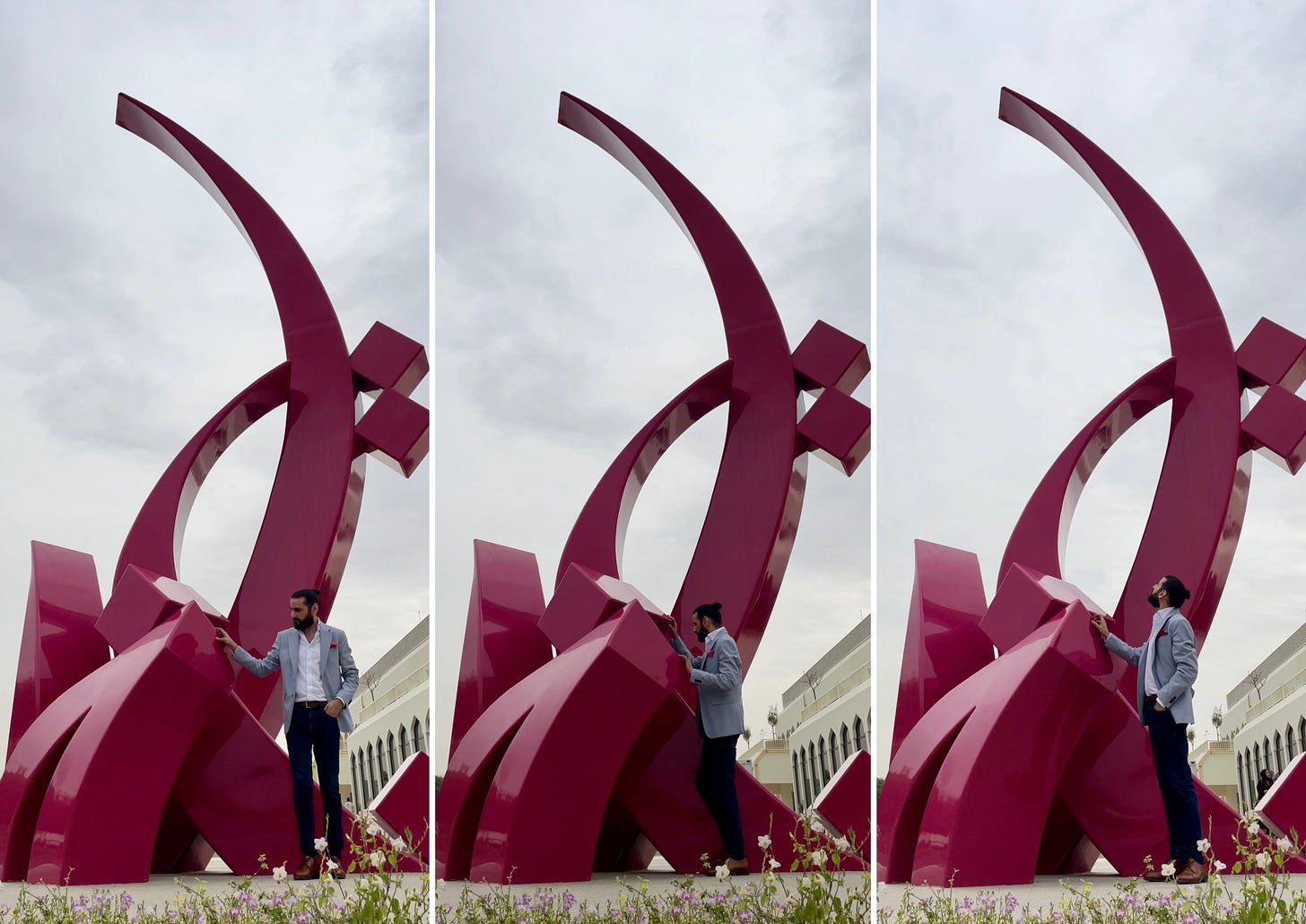
El Seed is really one of the pioneers who brought Arabic calligraphy to a main stream audience, showcasing it on the global stage though his fusion of street and pop art.
Not only did he make Arabic calligraphy accessible to a diverse number of people but he also made it, for a lack of a better word cool.
El Seed was also an artist-in-residence at Tashkeel in 2013 and had his first solo exhibition entitled Declaration at their gallery space.
I was really excited to speak to El Seed about Takhayyal on the day of its unveiling. We discussed the importance of constructive criticism for artists, how creating this work feels like a full circle moment for his practice and how he hopes people will interact with his public sculptures when they encounter them.
You can watch our video interview above or read the text transcript below. Enjoy.
Please note: some of the text below has been edited for readability.
Maan Jalal: How are you?
El Seed: I'm good and you?
Maan Jalal: I'm good, Al Hamdulila. Mabrook about this amazing work.
El Seed: Allah Yebarick feek man.
Maan Jalal: So I'm gonna ask you the same question I ask every artist about a piece of work- which was more challenging, starting or finishing this piece?
El Seed: I think this piece was not the start. It was like the process of something that started almost 10 years ago here, in Tashkeel, exactly where I start moving from 2D to 3D. So I think this is, I don't want to say the end of the process, but one point in this long process.
Maan Jalal: Does it feel like a full circle moment in a way?
El Seed: Yeah, definitely because I started working with 3D when I was doing my art residency in Tashkeel in 2013. And now Tashkeel is being renovated and so there is a new Tashkeel coming up and with a new sculpture here. I feel this is a homage to the spirit of Tashkeel about what it is and what it represents to me - this place where you can just think beyond the box - to imagine.
That's why like the word, the calligraphy says Takhayal - imagine. It allows you to break all these barriers and to imagine beyond any limit.
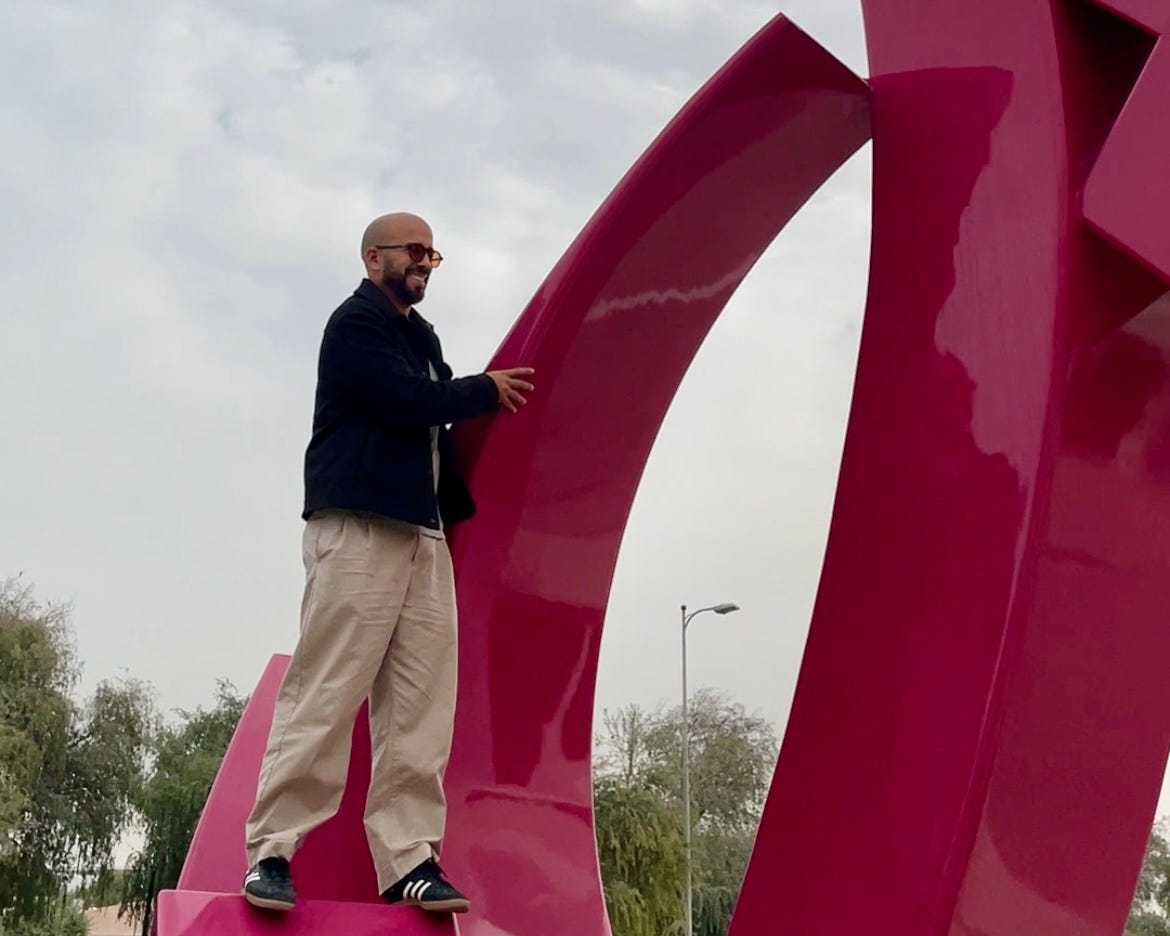
Maan Jalal: Tell me more a little bit about that collaborative process working with Tashkeel on the sculpture. Did they give you for reign? Did you do whatever you want, or was there a bit of back and forth and discussing?
El Seed: It was a back and forth with Shiekha Lateefa - she's a very good friend, she's a kind of sister to me. She's very critical of my work and that's what I appreciate about her. I think it's interesting as an artist to sometimes remove your ego and accept criticism from people who want you to to do well and to move forward and in a good way.
Maan Jalal: It's a critical thing for an artist - it's very important
“It's important for artists to speak with other people. Because sometimes somebody will guide you toward a path that you wouldn't take it,” El Seed
El Seed: Yeah and I appreciate that because she knows how to do it in the in the right way - not in an aggressive way. We know each other for more than 15 years now - so it was a back and forth. And the idea was really to create the word as if it was coming out of the ground, kind of a flame going up, a seed that you planted that goes up.
Maan Jalal: And do you think that kind of dialog, conversation, and critical appraisal of your work, does it also improve the work? When you look at the first designs of this wonderful sculpture, do you now see it and think it's so much different from my first idea?
El Seed: Actually, yesterday, I was speaking with her about this and I didn't even remember the first sketches. That's the funny thing. I went back to the archive, and I was like, ah, actually, this now definitely works better.
It's important for artists to speak to other people. Because sometimes somebody will guide you toward a path that you wouldn't take it. So I don't mind having people tell me, hey, what don't you think of this?
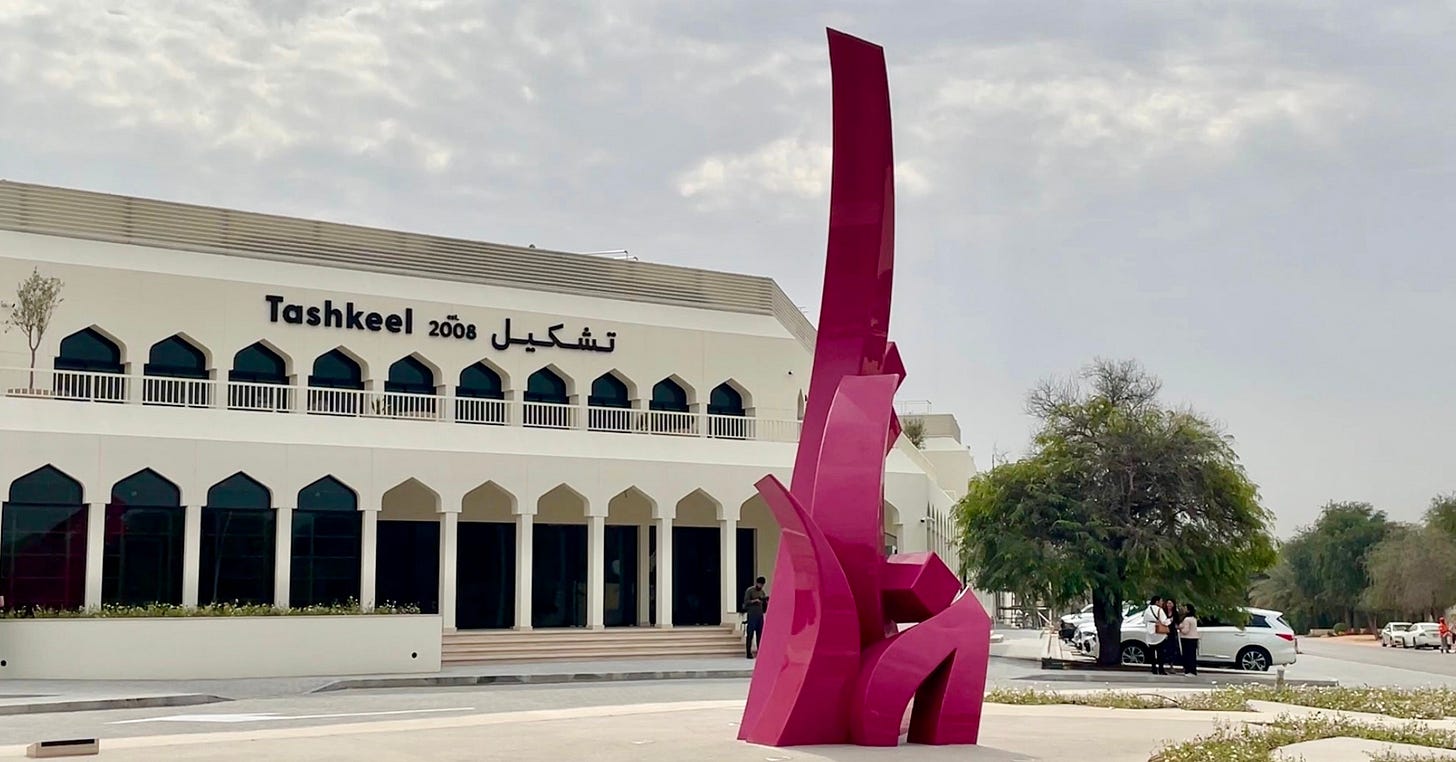
Maan Jalal: So you think also, for artists, it's important to doubt yourself sometimes?
El Seed: Yeah, definitely you have to do this otherwise it's an ego thing - you believe that you have the best opinion. I think it's always great sometimes to speak to people, people who are close to you, people who understand your practice, so they can tell you, actually, maybe, why didn't you think of this? And then on the other side, the person has to also find the right way to tell you. So it has to be conversation.
Maan Jalal: You said you started off 2D - now you're doing more 3D - when your work is coming off the page, or off the screen to become 3D, are there ever moments where you're like, 'oh, no, stop, I need to go back, something does not look right in the physical piece.’
El Seed: There's always tweaking but when I work with 3D I usually see the piece in my head. I draw it on paper and then these people in my team help me to make it as a 3D piece. It's a process.
The most difficult thing at the beginning was really to manage to explain to people who do modelization to make it as I saw it. There is a guy called the Bahar al Bahar, who's actually is the first guy who managed to understand. And I met him in Tashkeel. Because for a year I was making some tests and experiments and it didn't work. And Bahar, the funny party, was that he had a studio here. And then he managed, really, to help me to make it really concrete.
Maan Jalal: That's the point of places like Tashkeel, these spaces where you meet people and make these connections, right? I know that you really focus on the meanings of words and how they look. So how did you - I mean, it's a perfect word, really, for this, for this project - so I'm wondering how you came to it.
El Seed: Shiekha Lateefa she told me, I would love to have a sculpture that says takhayal - imagine. And I think this is definitely, like the spirit of Tashkeel. And since she told me this, I noticed that a lot of time when she speaks, she says, 'takhayal' alot. That's a beautiful way to start a sentence with that word. When you start a phrase with the word imagine, you allow yourself to expand the scope of possibility.
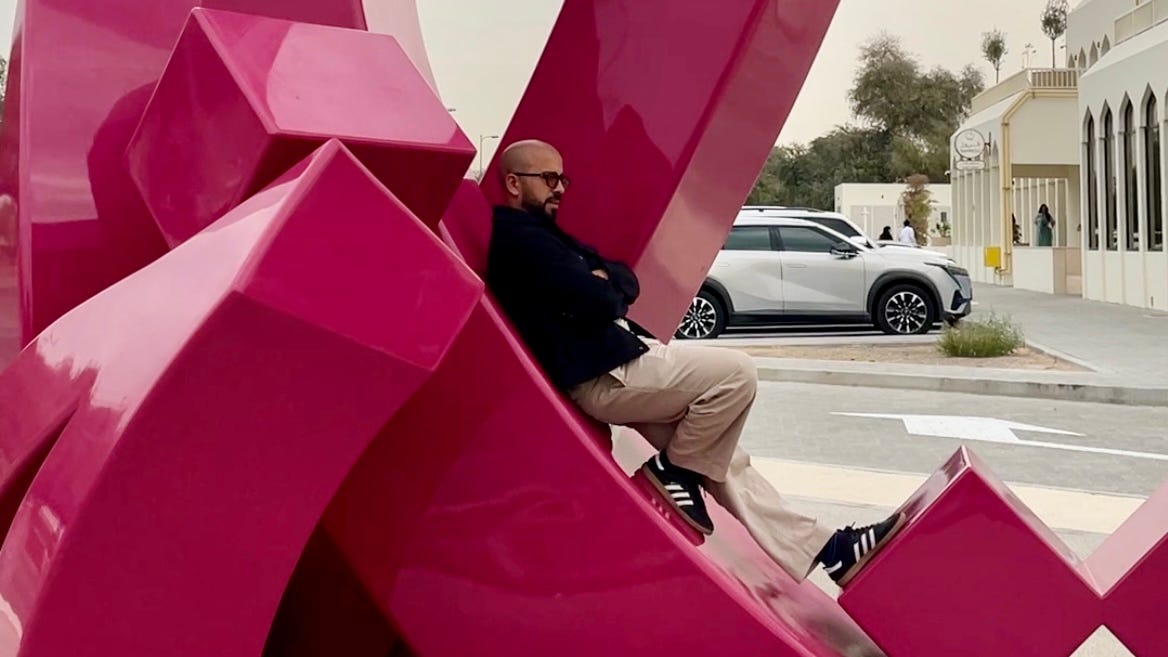
Maan Jalal: And when do you know when to stop designing how you're going to stylize the word? Like you said before, this great thing, it looks like it's coming out from the ground. But I always wonder when is too much? When is the word not a word anymore? And when is it still a word? Where is that balance?
El Seed: I don't see as a word. When I work with 3D I really see it as shapes and then I try to bring the letters or the shape of the letters to match the shape that I want to do. I build something as mostly like a shape, like a shakil - tashkeel1- and then the word comes. So that's the challenge to have a piece that represents something, in a way, but still, something that you can still decipher.
Maan Jalal: What I loved before is that you were jumping up on the sculpture. I don't think you recommend for people to do that generally.
El Seed: I do.
“I really want people to stop, come and take picture, climb on it and and hopefully feel inspired,” El Seed
Maan Jalal: Oh, you do? That's interesting, because I was gonna ask, when you have an artwork that's in the public sphere you kind of can't control who touches it, who doesn't touch it. So were you imagining people getting on there, touching it, getting on top?
El Seed: That's the point of it. If you create a piece in the public space and you don't allow people to interact with it, I think it's boring.
Most of the public arts pieces in the Arab world, unfortunately, were put on roundabouts, so you never interact with them. You see them, you turn around them, but you never get the chance to touch them.
And for me, this is the point of pieces like even the one I did in front of Dubai Opera, I want people to climb on it. So even sometimes I go there and I climb and then the security come they're like, 'no, no, you get down. You're not allowed' and I'm like, 'I'm allowing people to do this.'
That's the point, that's the beauty of it, to allow people to to interact with it, to climb it, and then for me, that's the best thing when people see something that I didn't intend.
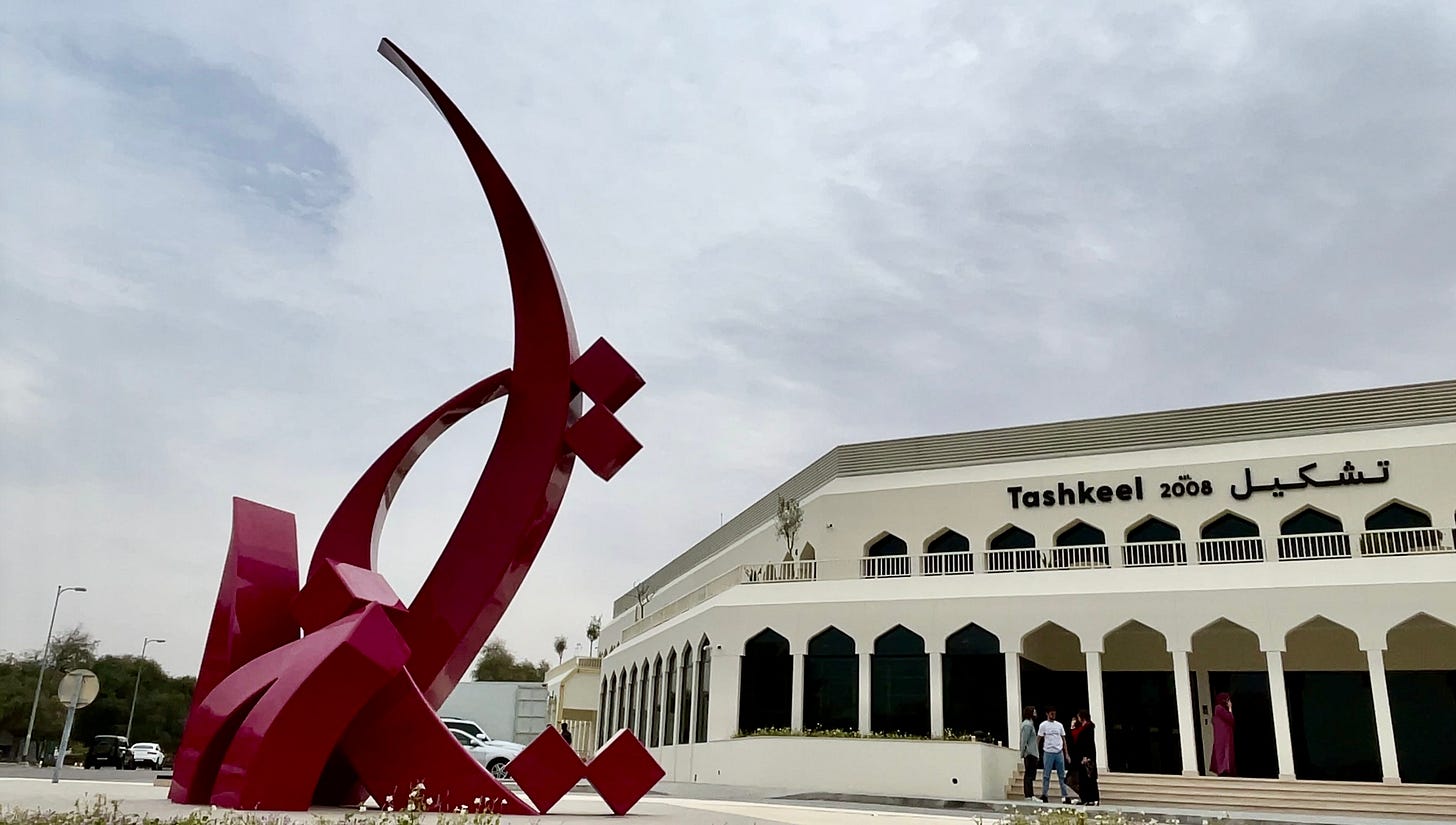
Maan Jalal: Can you tell me about the colour choice? Because it's a great color choice for the landscape here and for the building behind us. I'm wondering why you chose specific colour.
El Seed: Pink is actually a colour that I use in a lot of my work. It became like a signature. Even somebody told me I want to register the Panton 219C pink under your name. But actually Barbie, she did is before me so I'm pissed.
Maan Jalal: She got there before you.
El Seed: Yes, so sad (laughs). But, you know, when you look at classical calligraphy, the use of colour was not something that was really there. In calligraphy the mostly use gold and black and for me, using pink was a way of clashing with this, but also a way of expressing the one part of my identity, which is the graffiti culture, where you like, super flashy colour. And the piece in Tashkeel, when I did my first show, was pink - it was this first exhibition of sculpture that I did.
Maan Jalal: Again a full circle moment you’re coming back. The last question I wanted to ask you was, what do you hope people will feel or think when they first drive by here and see this work, when they first experience it?
El Seed: I think for surprise because that's the first thing you see. The first day I turned and I saw the piece… you don't expect to see that here. And then interaction. I really people to interact with it. I really want people to stop, come and take picture, climb on it and and hopefully feel inspired.
Tashkeel in Arabic refers to the word and concept of shapes. The artists studios Tashkeel, the location of El Seed’s new sculpture, has used this concept as word as their name. Here El Seed uses tashkeel as a pun to comment about the process of making shapes in his work while also referencing the studio.







Share this post